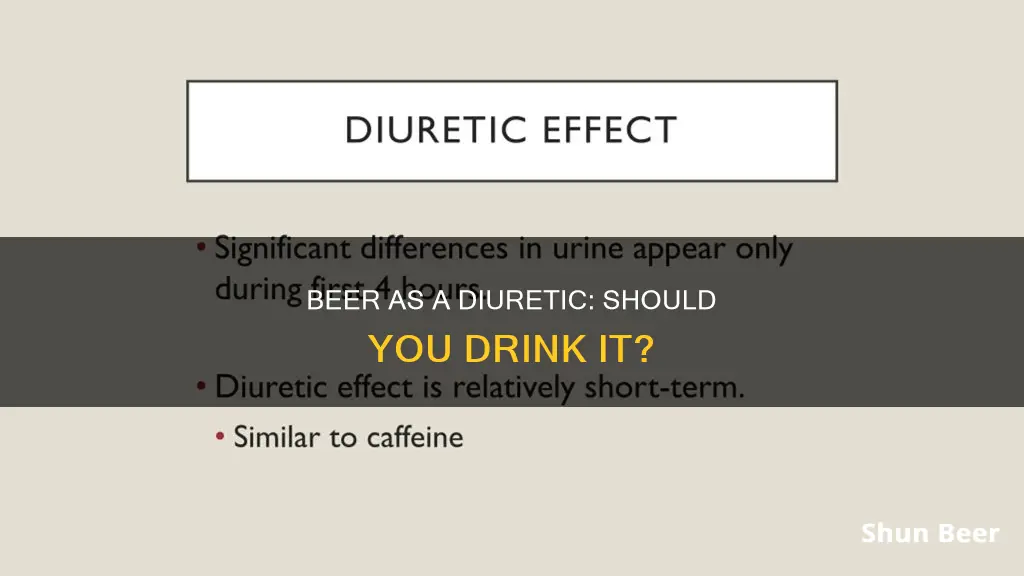
Alcohol is a diuretic, which means it increases urine output. Beer, a drink with a fairly low alcohol by volume (ABV), has a diuretic effect, but it is not as strong as that of wine or spirits.
Several studies have found that the stronger the alcoholic drink, the greater the diuretic effect. One study found that urine output after drinking a typical beer was no different from that of a non-alcoholic beer or water. Another study found that beer with 2% alcohol or less did not increase urine output.
The diuretic effect of alcohol is caused by its impact on the body's release of the hormone vasopressin, also known as the antidiuretic hormone (ADH). Typically, the brain signals the release of ADH in response to an increase in particles over fluids, which then signals the kidneys to hold on to water. By suppressing ADH, alcohol can make the kidneys release more water, leading to a dehydrating effect.
| Characteristics | Values |
|---|---|
| Alcohol content | The higher the alcohol content, the more diuretic the drink is. |
| Diuretic effect | Alcohol is a diuretic, which increases urine output. |
| Dehydration | Alcohol can cause dehydration. |
| Electrolyte balance | Alcohol can cause an electrolyte imbalance. |
| Rehydration | Non-alcoholic beer can rehydrate the body. |
| Urine output | Urine output increases with higher alcohol content. |
What You'll Learn
- Alcohol is a diuretic, increasing urine output
- Alcohol suppresses the antidiuretic hormone vasopressin, which usually causes the kidneys to retain water
- The more alcohol content in a drink, the more diuretic it is
- Beer with 2% alcohol or less did not increase urine output
- Non-alcoholic beer may have health benefits

Alcohol is a diuretic, increasing urine output
Alcohol is a diuretic, which means it increases urine output. If you’re peeing out more than you’re taking in, this can have a dehydrating effect.
Alcohol impacts our cognition, mood, balance, speech, and many other aspects of our physiology. This includes fluid balance and hydration. Despite alcohol’s historic worldwide popularity, we’re still largely unsure of exactly how it has these effects.
The studies do warn that stronger beers are likely to be more dehydrating, and that drinks containing essential electrolytes are still better for hydration. Nevertheless, the evidence points to beer not being all that bad from a hydration perspective.
It’s widely believed that alcohol exerts its diuretic effect by suppressing a hormone called vasopressin, or ADH. Vasopressin usually causes the kidneys to save water instead of passing it as urine. Alcohol therefore inhibits this critical water-saving mechanism inappropriately, which can lead to losing too much water and becoming dehydrated.
However, the studies suggesting this effect on vasopressin are quite old, so we’ve taken a look at some of the latest evidence to see if modern technology can confirm the theory.
Current studies still agree that alcohol increases urine output. However, they question whether the effect on vasopressin is solely to blame. Several studies have found that increased alcohol intake doesn’t correlate with decreased vasopressin levels—so is alcohol really suppressing vasopressin? It’s likely that alcohol causes diuresis, or excessive urination, in ways we just don’t know about yet.
The bottom line is that alcohol makes you pee more, causing you to lose more water. And this can potentially cause dehydration.
Is Drinking Old Beer Safe?
You may want to see also

Alcohol suppresses the antidiuretic hormone vasopressin, which usually causes the kidneys to retain water
Alcohol is a diuretic, which means it increases urine output. It does this by suppressing the antidiuretic hormone vasopressin, which usually causes the kidneys to retain water. Vasopressin is produced by the posterior pituitary gland and is regulated by the body's salt and water balance.
When alcohol is consumed, it decreases the hypothalamic vasopressin mRNA expression and the content of this hormone in the posterior pituitary. This reduces the stimulus of related V2 receptors in the basolateral membranes of the collecting tubules and ducts, decreasing the long-term gene expression of local aquaporins. It also halts the short-term translocation of these proteins from the intracellular vesicles to the apical membranes, reducing water permeability.
The extent of the triggering of water diuresis by alcohol depends on alcohol tolerance. While it does not substantially alter long-term water volume in serum, ethanol independently affects osmolality and further elicits short-term urine production.
The diuretic effect of alcohol is also influenced by the drinker's hydration status. If the drinker is already dehydrated, they will tend to produce less urine.
Beer and Zolpidem: Safe Mix or Health Risk?
You may want to see also

The more alcohol content in a drink, the more diuretic it is
Alcohol is a diuretic, which means it increases urine production. The more alcohol content in a drink, the more diuretic it is. This is because alcohol suppresses the release of the hormone vasopressin, which is also known as the antidiuretic hormone (ADH). Typically, the brain signals the release of ADH in response to an increase in particles over fluids (plasma osmolality). This signals the kidneys to hold on to water. However, when alcohol suppresses ADH, it can make the kidneys release more water, leading to a dehydrating effect on the body.
Research has shown that drinking moderate amounts of higher-alcohol beverages, such as wine and distilled liquors, resulted in a small diuretic effect when compared to lower-alcohol beverages, like beer. One study found that urine output increased when alcohol content went up from 2% to 4% compared to an alcohol-free drink. Another study found that only moderate amounts of stronger alcoholic beverages, such as wine and spirits, resulted in a short-term and small diuretic effect in elderly men, whereas weaker alcoholic beverages, such as beer, did not.
The Science of Beer: Foam Detectors Explained
You may want to see also

Beer with 2% alcohol or less did not increase urine output
Another study found that beer with 2% alcohol or less did not have any effect on blood-volume levels after exercise. This suggests that non-alcoholic beer can support the rehydration process and improve fluid balance.
However, it is important to note that stronger beers are likely to be more dehydrating. A study in the journal Alcohol and Alcoholism found that urine output increased when alcohol content went up from 2% to 4%. Therefore, while beer with 2% alcohol or less may not increase urine output, stronger beers are likely to have a diuretic effect.
Overall, the evidence suggests that while beer with a low alcohol content may not increase urine output, drinking stronger beers can lead to dehydration. It is important to drink in moderation and stay hydrated, especially when consuming alcoholic beverages.
Beer and Prostate Surgery: What You Can Drink Post-Op
You may want to see also

Non-alcoholic beer may have health benefits
Alcoholic drinks are diuretic, which means they increase urine output and can leave you feeling dehydrated. However, non-alcoholic beer has many health benefits and can be a good alternative if you want to avoid alcohol. Here are some of the health benefits of non-alcoholic beer:
- Promotes Post-Exercise Recovery: The sodium in non-alcoholic beer aids in recovery after exercise. The fluids and carbohydrates in beer also help the body recuperate after strenuous exercise.
- Rehydrates the Body: Studies have shown that beer with 2% alcohol or less did not increase urine output and had no effect on blood volume levels after exercise. Therefore, non-alcoholic beer supports the rehydration process and helps maintain fluid balance.
- Improves Cardiovascular Health: Non-alcoholic beer contains polyphenols such as polyphenol xanthohumol, a compound derived from hops, which can help reduce blood pressure, inflammation, and homocysteine levels. It can also increase endothelial progenitor cells, which repair and maintain the endothelial walls of blood vessels.
- May Stimulate Breast Milk Production: The barley in beer contains a polysaccharide that boosts milk flow. Non-alcoholic beer may also increase antioxidants in breast milk and decrease compounds related to oxidative stress in the mother's body.
- Reduces the Risk of Osteoporosis: Silicon, a non-alcoholic component of beer, may increase bone mineral density and reduce the risk of osteoporosis.
- Improves Copper Metabolism: One of the non-alcoholic components of beer promotes better copper metabolism, helping to reduce the severity of a copper deficiency, which can lead to joint pain, anemia, and weak bones.
- Promotes Better Sleep: The compounds xanthohumol and myrcenol in hops have a sedative effect and are thought to improve sleep patterns. Studies have shown that drinking non-alcoholic beer in the evening can help people fall asleep faster and improve sleep quality.
- Reduces Anxiety and Stress: Experimental studies have found that drinking non-alcoholic beer can reduce feelings of anxiety and stress. Participants who drank non-alcoholic beer for two weeks reported lower levels of anxiety and stress, and physical tests confirmed this effect.
- Keeps You Hydrated: A study on male soccer players showed that non-alcoholic beer maintained hydration better than water.
- Can Improve Bone Density: Non-alcoholic beer contains high amounts of silicon, which boosts collagen production, leading to healthier bones, blood vessels, hair, skin, and nails.
- Can Improve Circulation: The phenols in non-alcoholic beer can help reduce the risk of developing atherosclerosis (hardening of the arteries), which can lead to a heart attack or stroke.
- Improves Digestion: Non-alcoholic beer contains compounds such as folic acid and B vitamins, which may contribute to healthier digestion. Some studies suggest that alcohol-free beers may also stimulate the production of digestive enzymes, aiding the stomach in breaking down food.
Beer and Lamisil: Is It Safe to Mix?
You may want to see also
Frequently asked questions
Yes, beer has a diuretic effect as it increases urine output.
Beer with 2% alcohol or less did not increase urine output when compared to non-alcoholic beer.
Beer has a lower diuretic effect than stronger alcoholic drinks like wine and spirits.
Alcohol inhibits the release of the hormone vasopressin or anti-diuretic hormone (ADH), which signals the kidneys to hold on to water.
Drinking beer in moderation, along with plenty of water, can help reduce its diuretic effect.







